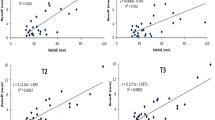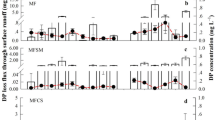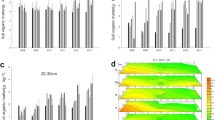Abstract
In order to test the efficacy of conservation tillage and optimized fertilization on reducing N and P runoff losses, a 4-year (2007–2011) runoff plot experiment was conducted in the Chaohu Lake region, East China. There were four treatments including: (1) conventional tillage (CT, basal fertilization without mulch), (2) conventional tillage with straw mulching (CTS), (3) optimized fertilization (OPF, split applications) and (4) no-tillage with straw mulching plus optimized fertilization (NTS + OPF). Results showed that CTS and NTS + OPF exhibited significant reduction of seasonal runoff and soil losses compared with CT (P < 0.05). OPF decreased runoff by 6–10 and soil loss by 9–27 % in the various years, but differences were not always statistically significant. Interestingly, winter wheat and rapeseed yields were on average higher in the conservation tillage and optimized fertilization treatment than in the CT treatment. Compared with CT, CTS reduced N losses by 14–25 %, OPF by 12–21 % and NTS + OPF 20–28 %. Similarly, CTS reduced P losses by 20–32 %, OPF by 11–21 % and NTS + OPF by 23–30 %. NTS + OPF was the most effective treatment for reducing nutrient losses. The reduction of runoff volume was mainly responsible for the decreased nutrient losses. Our findings indicates that conservation tillage and optimized fertilization may reduce N and P losses via runoff while maintaining or enhancing crop yields during the winter-crop growing seasons in the Chaohu Lake region.







Similar content being viewed by others
References
Balwinder-Singh, Humphreys E, Eberbach PL, Katupitiya A, Yadvinder-Singh, Kukal SS (2011) Growth, yield and water productivity of zero till wheat as affected by rice straw mulch and irrigation schedule. Field Crop Res 121:209–225
Bloom PR, McBride MB, Weaver RM (1979) Aluminum organic matter in acid soils: buffering and solution aluminum activity. Soil Sci Soc Am J 43:488–493
Bronick CJ, Lal R (2005) Soil structure and management: a review. Geoderma 124:3–22
Chan KY, Heenan DP, Oates A (2002) Soil carbon fractions and relationship to soil quality under different tillage and stubble management. Soil Tillage Res 63:133–139
Committee of Analytical Method of Water and Wastewater (2002) Analytical method of water and wastewater. China Environment Science Press, Be**g
Dobermann A, Fairhurst TH (2002) Rice straw management. Better Crop Int 16:7–9
Dunne T (1983) Relation of field studies and modeling in the prediction of storm runoff. J Hydrol 65:25–48
Gupta PK, Sahai S, Singh N, Dixit CK, Singh DP, Sharma C, Tiwari MK, Gupta PK, Garg SC (2004) Residue burning in rice-wheat crop** system: causes and implications. Curr Sci 87:1713–1717
Horton RE (1993) The role of infiltration in the hydrologic cycle. Trans Am Geophys Union 14:446–460
Jordán A, Zavala LM, Gil J (2010) Effects of mulching on soil physical properties and runoff under semi-arid conditions in Southern Spain. Catena 81:77–85
Kahlon MS, Lal R, Ann-Varghese M (2013) Twenty two years of tillage and mulching impacts on soil physical characteristics and carbon sequestration in Central Ohio. Soil Tillage Res 126:151–158
Kessel CV, Clough T, Van Groenigen JW (2009) Dissolved organic nitrogen: an overlooked pathway of nitrogen loss from agricultural systems? J Environ Qual 38:393–401
Lampurlanes J, Angas P, Cantero-Martinez C (2002) Tillage effects on water storage during fallow, and on barley root growth and yield in two contrasting soils of the semi-arid Segarra region in Spain. Soil Tillage Res 65:207–220
Liu ZD, Yu XG, Wang ZX (2003) The current water pollution of Taihu drainage basin and the new management proposals. J Nat Resour 18(4):465–473
Liu Y, Tao Y, Wan KY, Zhang GS, Liu DB, ** land subjected to different surface mulching practices in the Danjiangkou Reservoir area of China. Agric Water Manag 110:34–40
Luo ZX, Wei QS, Wang ZH, Yan CZ (2010) Bioavailability of dissolved organic nitrogen in freshwaters to toxic algae. Ecol Environ Sci 19(1):45–50 (in Chinese)
Mathys N, Klotz S, Esteves M, Descroix L, Lapetite JM (2005) Runoff and erosion in the Black Marls of the French Alps: observations and measurements at the plot scale. Catena 63:261–281
Melero S, López-Bellido RJ, López-Bellido L, Muñoz-Romero V, Moreno F, Murillo JM (2011) Long-term effect of tillage, rotation and nitrogen fertiliser on soil quality in a Mediterranean Vertisol. Soil Tillage Res 114:97–107
Mullen RW (2011) Nutrient cycling in soils: nitrogen. In: Hatfield JL, Sauer TJ (eds) Soil management: building a stable base for agriculture. American Society of Agronomy and Soil Science Society of America, Madison, pp 67–78
Murphy J, Riley J (1962) A modified single solution method for the determination of phosphate in nature waters. Anal Chim Acta 27(1):31–36
Nyssen J, Poesen J, Moeyersons J, Haile M, Deckers J (2008) Dynamics of soil erosion rates and controlling factors in the Northern Ethiopian Highlands–towards a sediment budget. Earth Surf Process Landf 33:695–711
Paul BK, Vanlauwe B, Ayuke F, Gassner A, Hoogmoed M, Hurisso TT, Koala S, Lelei D, Ndabamenye T, Six J, Pulleman MM (2013) Medium-term impact of tillage and residue management on soil aggregate stability, soil carbon and crop productivity. Agric Ecosyst Environ 164:14–22
Rathke GW, Behrens T, Diepenbrock W (2006) Integrated nitrogen management strategies to improve seed yield, oil content and nitrogen efficiency of winter oilseed rape (Brassica napus L.): a review. Agric Ecosyst Environ 117:80–108
Rayment GE, Higginson FR (1992) Australian laboratory handbook of soil and water chemical methods. Inkata Press, Sydney
Schulthess CP, Sparks DL (1992) Equilibrium-based modeling of chemical sorption on soils and soil constituents. Adv Soil Sci 16:121–163
Sharpey AN, Withers PJA (1994) The environmentally-sound management of agricultural phosphorus. Fertili Res 39:133–146
Smith VH, Tilman GD, Nekola JC (1999) Eutrophication: impacts of excess nutrient input in freshwater, marine and terrestrial ecosystems. Environ Pollut 100:179–196
Smith DR, Owens PR, Leytem AB, Warnemuende EA (2007) Nutrient losses from manure and fertilizer applications as impacted by time to first runoff event. Environ Pollut 147:131–137
Sun B, Zhang LX, Yang LZ, Zhang FS, Norse D, Zhu ZL (2012) Agricultural non-point source pollution in China: causes and mitigation measures. Ambio 41:370–379
Tan DS, Jiang LH, Tan SY, Zheng FL, Xu Y, Cui RZ, Wang M, Shi J, Li GS, Liu ZH (2013) An in situ study of inorganic nitrogen flow under different fertilization treatments on a wheat–maize rotation system surrounding Nansi Lake, China. Agric Water Manag 123:45–54
Tian YH, Ying B, Yang LZ, Yin SX, Zhu ZL (2007) Nitrogen runoff and leaching losses during rice–wheat rotation in Taihu Lake Region, China. Pedosphere 17:445–456
Tullberg JN, Yule DF, McGarry D (2007) Controlled traffic farming—from research to adoption in Australia. Soil Tillage Res 97:272–281
Ulén B, Bechmann M, Fölster J, Jarvie HP, Tunney H (2007) Agriculture as a phosphorus source for eutrophication in the north-west European countries, Norway, Sweden, United Kingdom and Ireland: a review. Soil Use Manag 23(Suppl. 1):5–15
US EPA (1986) Quality criteria for water. Office of water regulation and standards. EPA-440/586-001
Wang J, Guo XS, Wang YQ, Ding SW (2010) Effects of conservation tillage and balanced fertilization on nitrogen loss from paddy field and rice yields in Chaohu Lake region. J Agro-Environ Sci 29(6):1164–1171
Won CH, Choi YH, Shin MH, Lim KJ, Choi JD (2012) Effects of rice straw mats on runoff and sediment discharge in a laboratory. Geoderma 189–190:164–169
Yang LX, Yang GS (2010) Effects of phosphorus application on P forms in runoff from rice field of Taihu Watershed. J Soil Water Conserv 24:31–34 (in Chinese)
Yang JL, Zhang GL, Shi XZ, Wang HJ, Cao ZH, Ritsema CJ (2009) Dynamic changes of nitrogen and phosphorus losses in ephemeral runoff processes by typical storm events in Sichuan Basin, Southwest China. Soil Tillage Res 105:292–299
Yang LB, Lei K, Meng W, Fu G, Yan WJ (2013) Temporal and spatial changes in nutrients and chlorophyll-α in a shallow lake, Lake Chaohu, China: an 11-year investigation. J Environ Sci 25(6):1117–1123
Zhang HC, Cao ZH, Wang GP, Zhang HA, Wong MH (2003) Winter runoff losses of phosphorus from paddy soils in the Taihu Lake Region of South China. Chemosphere 52:1461–1466
Zhang YL, Zhang XC, Shao MA, Li SQ (2004) Impact of straw cover on mineral nitrogen loss by runoff on loess slope. J Soil Water Conserv 18(1):85–88 (in Chinese)
Zhang JH, Liu JL, Zhang JB, Cheng YN, Wang WP (2013) Nitrate-nitrogen dynamics and nitrogen budgets in rice–wheat rotations in Taihu Lake region, China. Pedosphere 23(1):59–69
Zhao X, Zhou Y, Min J, Wang SQ, Shi WM, **ng GX (2012) Nitrogen runoff dominates water nitrogen pollution from rice–wheat rotation in the Taihu Lake region of China. Agric Ecosyst Environ 156:1–11
Acknowledgments
This work was supported by the National Natural Science Foundation of China (Grant No. 41401308), National Key Technology R&D Program (Grant Nos. 2012BAD15B03 and 2007BAD87B06) and the Anhui Province Technical Program (Grant No. 1406c085025). We greatly thank editors and anonymous reviewers for their helpful comments and suggestions on earlier drafts of this manuscript. We specially thank Prof. Oene Oenema, from Environmental Sciences, Wageningen University, for his professional advices and help with English language. We also thank Dr. Yin Ye, from Soil and Fertilizer Research Institute, Anhui Academy of Agricultural Sciences, for his technical support on artwork.
Author information
Authors and Affiliations
Corresponding authors
Rights and permissions
About this article
Cite this article
Wang, J., Lü, G., Guo, X. et al. Conservation tillage and optimized fertilization reduce winter runoff losses of nitrogen and phosphorus from farmland in the Chaohu Lake region, China. Nutr Cycl Agroecosyst 101, 93–106 (2015). https://doi.org/10.1007/s10705-014-9664-3
Received:
Accepted:
Published:
Issue Date:
DOI: https://doi.org/10.1007/s10705-014-9664-3




